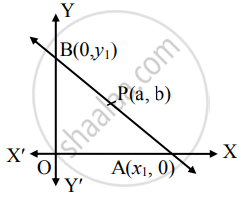Advertisements
Advertisements
प्रश्न
Answer the following question:
P(a, b) is the mid point of a line segment between axes. Show that the equation of the line is `x/"a" + y/"b"` = 2
उत्तर

Let the intercepts of a line AB be x1 and y1 on the X and Y-axes respectively.
∴ A ≡ (x1, 0), B ≡ (0, y1)
P(a, b) is the midpoint of a line segment AB intercepted between the axes.
∴ P = `(("x"_1+0)/2,(0+"y"_1)/2)`
∴ (a, b) = `("x"_1/2,"y"_1/2)`
∴ a = `"x"_1/2`
∴ x1 = 2a
and b = `"y"_1/2`
∴ y1 = 2b
∴ Equation of the required line AB is
`"x"/"x"_1+"y"/"y"_1` = 1
∴ `"x"/(2"a")+"y"/(2"b")` = 1
∴ `"x"/"a" + "y"/"b"` = 2
APPEARS IN
संबंधित प्रश्न
Write the equation of the line :
parallel to the X−axis and at a distance of 5 unit form it and above it
Write the equation of the line :
parallel to the X-axis and at a distance of 4 unit form the point (−2, 3)
Obtain the equation of the line containing the point :
B(4, –3) and parallel to the X-axis
Find the equation of the line passing through the points P(2, 1) and Q(2, –1)
Find the equation of the line passing through the origin and parallel to AB, where A is (2, 4) and B is (1, 7)
Find the equation of the line having slope `1/2` and containing the point (3, −2).
Find the equation of the line passing through the origin and which bisects the portion of the line 3x + y = 6 intercepted between the co-ordinate axes.
Find the x and y intercept of the following line:
`x/3 + y/2` = 1
Find equations of lines which contains the point A(1, 3) and the sum of whose intercepts on the coordinate axes is zero.
Find equations of lines containing the point A(3, 4) and making equal intercepts on the co-ordinates axes.
N(3, −4) is the foot of the perpendicular drawn from the origin to line L. Find the equation of line L.
Select the correct option from the given alternatives:
If the line kx + 4y = 6 passes through the point of intersection of the two lines 2x + 3y = 4 and 3x + 4y = 5, then k =
Answer the following question:
Reduce the equation 6x + 3y + 8 = 0 into slope-intercept form. Hence find its slope
Answer the following question:
Does point A(2, 3) lie on the line 3x + 2y – 6 = 0? Give reason.
Answer the following question:
Obtain the equation of the line containing the point (2, 3) and parallel to the X-axis.
Answer the following question:
Find the equation of the line having slope 5 and containing point A(–1, 2).
Answer the following question:
Find the equation of the line passing through the points S(2, 1) and T(2, 3)
Answer the following question:
Find the equation of the line which contains the point A(3, 5) and makes equal intercepts on the co-ordinates axes.
Answer the following question:
The vertices of a triangle are A(1, 4), B(2, 3) and C(1, 6). Find equations of the medians.
Answer the following question:
The vertices of a triangle are A(1, 4), B(2, 3) and C(1, 6) Find equations of Perpendicular bisectors of sides
Answer the following question:
Find the equation of the line through A(−2, 3) and perpendicular to the line through S(1, 2) and T(2, 5)
Answer the following question:
Show that there is only one line which passes through B(5, 5) and the sum of whose intercept is zero.
If the equation kxy + 5x + 3y + 2 = 0 represents a pair of lines, then k = ____________.
If (a, −2a), a > 0 is the mid-point of a line segment intercepted between the co-ordinate axes, then the equation of the line is ____________.
The lines `(x + 1)/(-10) = (y + 3)/-1 = (z - 4)/1` and `(x + 10)/(-1) = (y + 1)/-3 = (z - 1)/4` intersect at the point ______
The point A(b, a) lies on the straight line 2x + 3y = 13 and the point B(a, b) lies on the straight line -x + 4y = 5, then the equation of line AB is ______
The intercept of a line between the coordinate axes is divided by the point (1, 3) in the ratio 3 : 1. The equation of the line will be ______
A Plane cuts the coordinate axes X, Y, Z at A, B, C respectively such that the centroid of the Δ ABC is (6, 6, 3). Then the equation of that plane is ______.
The angle between the lines x sin 60° + y cos 60° = 5 and x sin 30° + y cos 30° = 7 is ______
Suppose the line `(x - 2)/α = ("y" - 2)/(-5) = ("z" + 2)/2` lies on the plane x + 3y – 2z + β = 0. Then (α + β) is equal to ______.
Area of the parallelogram formed by the lines y = mx, y = mx + 1, y = nx and y = nx + 1 is equal to ______.
N(3, – 4) is the foot of the perpendicular drawn from the origin to a line L. Then, the equation of the line L is ______.
